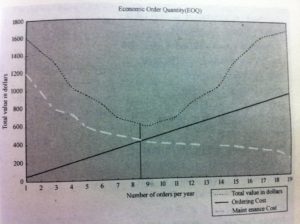Logistics Strategy

On the other hand, capital cost increases with the lot size, on the other hand, the interest accrues on the capital invested in the carrying inventory, which is, in many cases, computed according to the prime interest rate or a specified rate pegged to the prime interest. the logic behind it is that the cash to replace capital invested in inventory can be purchased in the money market.
In many countries, taxes are levied on the average inventory level on a specific day of the year.
Insurance cost is a direct levy normally based on estimated risk or exposure over time.
Obsolescence means the deterioration of product in storage which is not covered by insurance.
The storage cost incurs in respect of product holding, whether you store the goods in a public warehouse, rented private warehouse or a warehouse you own yourself. the cost, which can well amount to over 37% of the total logistics cost, results in the necessity of making plans for inventory.
The plan should be able to answer three basic questions: when to order, how much to order and inventory control procedures.
For the time being we are concerned only with the question of how much to order. the lot sizing concept balances the cost of maintaining inventories against the cost of ordering the key to understanding the relationship is to remember that average inventory is equal to one-half the order quantity. the larger the order quantity, the fewer orders required per planning period and, consequently, the lower the total ordering cost. lot quantity formulations identify the precise quantities at which the annual combined total cost of ordering and maintenance is lowest for a given sales volume.
In the figure, the point where the curve of dashes crosses with the straight is the point for most economical number of orders.


